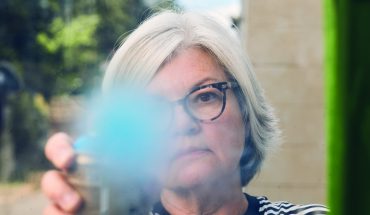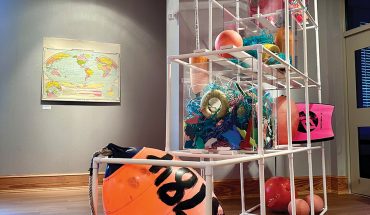by Ann Brooke Raynal
illustrations by Ippy Patterson
Family came first for Sabrina Goode’s father, Robert Akins Goode, and for her mother, Emily Morgan Goode. Maybe that’s why, even though they lived a military life that took them far and wide, the Goodes continued to bring their own children back to visit Raleigh. It’s where they both grew up in the ’20s and ’30s, just blocks away from one another in Raleigh’s Oberlin Village.
After Robert Goode’s retirement in 1976 and his permanent return to Raleigh, among his many civic acts was cleaning up his old neighborhood’s deteriorating, ancient Oberlin Road cemetery. It is work his daughter is carrying on today with the Friends of Oberlin, a volunteer group committed to preserving and educating the public about this still-crumbling, often-overlooked piece of Raleigh’s cultural history.
The graveyard, established in 1873, provides its own physical history lesson spanning centuries. Thought to have originally served as a graveyard for slaves, it is filled with the remains of former residents of the original Oberlin Village, an African-American community that was home to emancipated slaves and others during Reconstruction. Its three acres lie hidden just off Oberlin Road, behind the building that houses the domestic violence prevention agency InterAct, and under tall pines and fallen leaves.
Formerly owned by wealthy plantation owner Duncan Cameron, the land was deeded to the people of Oberlin Village in 1873 with the requirement that it be used as a cemetery. It’s a plot of land owned by no individual, by no city, by no county or state, but instead by the “citizens of Oberlin Village.”
Some graves hold the remains of former slaves. Near them lie the graves of doctors, teachers and state senators. The variation in the markers themselves indicates time period as well as the relative wealth of residents; some are carved marble monuments, some granite or cast concrete. Other graves are marked with simple fieldstones indicating head and foot, and a few were made of wood.
Many graves bear the Masonic insignia, as a number of the Oberlin Village residents were freemasons. Most of the wooden grave markers have long decomposed, but one ancient wooden marker remains, cradled in the arms of a magnolia root.
In Februrary, the Raleigh City Council voted to name the cemetery a Raleigh Historic Landmark. But the work to preserve it is just beginning.
Born in France and raised in Alaska, Sabrina Goode, 54, is up to the task. A world traveler when she’s not working as an interior design consultant with Ethan Allen, she and fellow designer Donna Bailey established the “Friends of Oberlin” two years ago.
“I was telling Donna about my family history and about the state of the graves. I was afraid if nothing was done, this history would just be lost.”
Because no one person owns the cemetery, Goode explains, “It’s very hard to get people to take responsibility for the upkeep.” Some, including her father, “have done work here and there over the years, but there’s been no sustained attention.”
After the Civil War, a large black community sprang up just outside Raleigh when white landowner Lewis Peck sold lots to African-Americans for $50 an acre.
According to oral tradition, says Dr. Ruth Little, an anthropologist and fellow “Friend of Oberlin,” the Cameron family also gave home sites along Oberlin Road to their emancipated slaves.
First called “Peck’s Place,” the growing village was soon re-named “Oberlin” after the Ohio college attended by village founder and North Carolina state senator James E. Harris.
The village grew and prospered. By the 1880s, there were 750 residents, mostly farmers, tradespeople, and skilled workers, many of whom actually built Raleigh from the ground up. They provided brick, stone, and masonry work not only for the houses and businesses along Oberlin Road but also for the state capitol and other significant downtown buildings. Notable Raleighites, like James E. Shepard, founder of N.C. Central University, grew up in Oberlin Village.
A public grade school that pre-dated the city’s grade schools was established and eventually moved near the site of what is now InterAct, next to the cemetery. And two black congregations were founded: Wilson Temple United Methodist, across and up the street from the cemetery, and Oberlin Road Baptist, next to the cemetery, both of which are thriving congregations today.
Sabrina Goode’s mother attended Wilson Temple, the church her ancestors helped found. Wilson Morgan, Goode’s great-great- great grandfather – and North Carolina’s first African-American state senator – donated the land for Wilson Temple.
And her father was a life-long member of Oberlin Road Baptist. After moving back to Raleigh, Goode’s parents attended the churches in which they grew up. Sabrina and her five brothers and sisters would choose which church to attend each Sunday, sometimes wooed by one or the other parent. “That was life along Oberlin Road. There was such sense of community, a sense of joy and fun,” Goode muses. “We knew our history and it made us proud.”
Planning ahead
The entrance to the cemetery lies next to the dumpsters in InterAct’s parking lot, a view Sabrina Goode deplores. In addition to lobbying for the relocation of the dumpsters, the “Friends of Oberlin” want to have the graves thermally scanned at a cost of about $8,000. The scanning would show the exact location of each grave, and reveal unmarked graves, but the cost far exceeds the group’s tiny budget. In fact, though the cemetery was designated a historic landmark, the group can’t purchase a permanent marker until they find the money.
Community partners who know about the cemetery have helped along the way. A couple of Eagle Scouts built a kiosk, benches and cobblestone steps. Local businesses including McDonald’s and the Flying Biscuit café have donated money and food for clean-up efforts.
Unfortunately, summer storms have littered the cemetery with large limbs and debris, and its condition is worse than it was in the spring. The “Friends” plan a large-scale clean-up the morning of Nov. 2 and welcome any help they can get.
“For me, it’s about honoring the past and honoring the people who are there—unseen, unknown, forgotten,” Goode says.






